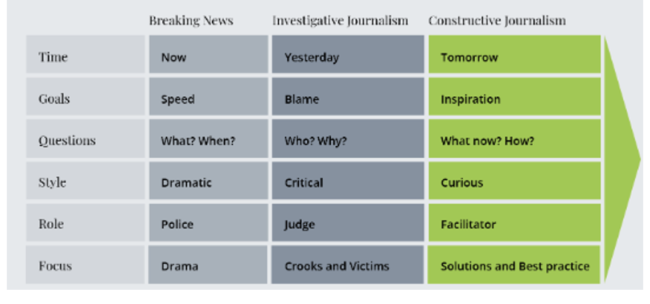“Listen to the people who are talking about how to fix what’s wrong, not the ones who just work people into a snit over the problems. Listen to the people who have ideas about how to fix things, not the ones who just blame others.”
That’s Molly Ivins writing in “You Got to Dance With Them That Brung You.” Who doesn’t love Molly Ivins?
(That is a rhetorical question.)
Ivins was writing about politics, which she did for years with bracing intelligence liberally spiced with snark. (Political-leaning pun intended.) But she could have been making an argument for what is called solutions journalism or constructive journalism. I believe it is the kind of work we should all be doing. I believe it is the work we must be doing.
Here’s how the non-profit Solutions Journalism Network defines this approach: “…rigorous, evidence-based reporting on the responses to social problems” the mission of which is “to transform journalism so that all people have access to news that helps them envision and build a more equitable world.” You will probably agree that Molly’s version has a bit more bite to it.
Solutions Journalism may not be a household/newsroom word, but it is not a new concept. In 2010, New York Times journalists David Bornstein and Tina Rosenberg launched a column called “Fixes” that focused on solutions to problems — from affordable housing to unhealthy food in prisons —and explored whether the efforts to mitigate these problems were working. In 2013 they helped establish the Solutions Journalism Network to further this approach. In the years that followed, news outlets around the country began to publish solutions-oriented stories.
But shrinking newsrooms, vanishing news outlets and the resource-heavy burden of thoughtful, in-depth reporting like this leads me to want to reinforce the case for solutions journalism and to shout it from the (virtual) hilltops.
Limits to making people care
We live in such perilous times, enmeshed in what seem to be unsolvable problems, brought to our knees by daily tragedies, deafened by rancorous rhetoric. If there ever was a time for journalists to step up — really step up — it is now. We need to consider not just what we write about but how we write about it, how we frame it. I think the key to reporting on any persistent difficult issue facing us now and beyond is reframing how we talk about it in order to truly engage and empower our audiences.
The old approach was MAKE THEM AWARE! Tell people how bad things are, and things will change. This is often a narrative of statistics, those jaw-dropping numbers that show the impact of what we are doing to the planet, how many people are sleeping on the streets, how many opioid overdoses, how many mass shootings.
The statistics represent people. But statistics are very easy to distance oneself from. And the bigger the number, the harder it is for people to understand and relate. Here’s an example: Internet users generate about 2.5 quintillion bytes of data each day. What does that mean? How do we wrap our minds around it? Does it matter? Should it matter?
We’re learning that statistics don’t move people.
Plus: We’re learning that statistics don’t move people. As a Forbes magazine article so cleverly put it: Why Storytelling Beats Statistics, But Only 100% Of The Time.
We have tried the make-them-aware approach by presenting readers with numbers, assaulting them with scary research and overloading them with disturbing comments from experts. If they just knew, we think. But it is increasingly obvious that this doesn’t work. Everyone who wants to know already knows. Those who don’t know (or don’t trust the “messenger”) cannot be reached or persuaded otherwise.
The next approach journalism tried was MAKE PEOPLE CARE!! Show readers that others (individuals, families, communities, etc.) are being affected by an issue or abuse, and they will care and things will change. How did we do that? Through heart-wrenching stories of disaster. We basically batter readers with trauma through words and images and sound. We also have now a generation of research that shows how this approach does not work.
In a previous essay for Storyboard, I wrote about the work of decision scientist Paul Slovic who pioneered the study of what he calls “psychic numbing” and what others of us call “compassion exhaustion.” This is actually a protective psychological response embedded in humans: How much can we care and cry and feel pain about the stories of others? It turns out there is a limit. Nonprofits have long specialized in this kind of messaging — but many of those they are trying to reach have been numbed by it. It’s not that they don’t care; it’s that there’s a limit to how much one can care.
So what can we do?
Stories can empower people
Enter solutions journalism. We need to be showing our audience — those who are already aware, those who maybe started off caring but have become psychically numb — that there are people, communities, tribes, organizations, etc. out there working on, experimenting with, learning from both successful and not-so-successful attempts to tackle the problems we all face. This is storytelling that EMPOWERS PEOPLE.
This kind of storytelling is nuanced. It is, obviously, about “solutions” and alternatives. But beneath, or maybe beyond, all that, it is about resilience and empowerment. Our audiences need to see that as individuals, as members of their families, as organizations and communities, they have power — and they can wield that power.
Our audiences need to see that as individuals, as members of their families, as organizations and communities, they have power — and they can wield that power.
Readers see this when we write about solutions, when they see others exerting their power. Blasting people with dire statistics and traumatic stories actually robs them of a feeling of agency or self-efficacy. Reframing the way we tell stories can give back a sense of power and engagement.
Does this solutions approach smack of advocacy? Yes. Sort of. But what it advocates is for societal engagement — engagement with engagement with issues, involvement in community and commitment to facing and mitigating the problems that plague us. It does not advocate a political, philosophical or religious position. The “cause” it promotes is citizenship.
Also important to understand: Solutions-framed journalism is not what is criticized or dismissed as happy news or feel-good journalism. There is room for these cheerful stories, and plenty of serious publications are paying heed. Talking Heads cofounder David Byrne launched a website called “Reasons to be Cheerful,” filled with good-news content. “It often seems like the world is going straight to hell,” he told Rolling Stone. “Hell, I wake up in the morning, I look at the paper, and…often I’m depressed all day.” Columbia Journalism Review, in covering this happy landscape, reports that Mother Jones has a newsletter focusing on positive news; the Washington Post has one filled with “inspiring” stories.
But solutions journalism stories are not heart-warming, smiley-face tales of success. They are complex, up-and-down narratives of efforts made, challenges faced, dead ends encountered, bridges burned, bridges built, persistence (maybe) rewarded, lessons learned.
Lighting a path forward
A year ago, The New York Times launched an inventive, interactive twist to Solutions Journalism, an initiative called “Headway.” Its mission: “Exploring the world’s challenges through the lens of progress.” The first project to come from that initiative was “Hindsight,” a collection of stories that explore what people in the past expected the future would bring, what actually happened and what we might learn from this. It is not a simple take on philosopher George Santayana’s famous quip that those who don’t know history are doomed to repeat it. It is far more subtle. The stories aim to help define progress, “how we measure it and how we make it,” according to the project’s launch letter by editor Matthew Thompson: “We don’t expect to find simple answers. But the pursuit itself may light the paths to our best futures.”
That, it seems to me, is one of the most empowering statements that can be made.
From Denmark comes a similar approach, the Constructive Institute: Journalism for Tomorrow, a “global hub for people who believe that journalism might be part of the problem in the trust meltdown in our democracies” – and that it (we) need to be part of the solution. Here’s how the Institute frames the approach:

We may have forgotten, or perhaps we never realized, that our best efforts to chronicle what in my J-school days we used to call the trifecta — crime, upheaval and disaster — often undermines community efforts to problem-solve. We are, in fact, part of the problem when we, with the best intentions, overwhelm and numb our readers, when our work contributes to their feeling that all is lost, that nothing can be done, that as David Byrne put it, “the world is going to hell.”
Solutions journalism is not the solution to disempowerment, disengagement, distrust and apathy on the part of too many Americans. There is no single solution.
But it is one path. And a noble role of journalism is to illuminate that path.
***
Lauren Kessler’s two most recent books, “Grip of Time: When Prison is Your Life” and “Free: Two Years, Six Lives, and the Long Journey Home,” take readers into the worlds of incarceration and reentry. She continues to correspond with and edit the work of the men in the prison writing group she founded in 2016.



